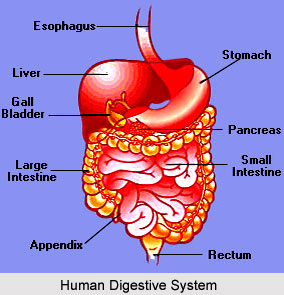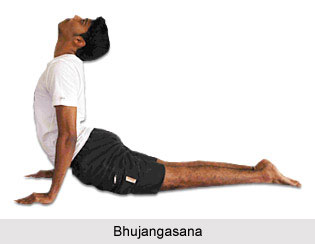Digestive System in human body is also known as alimentary or gastrointestinal system. It provides nourishment to all the body cells from the external environment. Food intake, its digestion, absorption and assimilation; water balance, elimination of residue, waste products and poisonous substances are the main functions of this system. The system includes gastrointestinal tract (alimentary canal), salivary glands and portions of liver and pancreas. The alimentary canal is a continuous tube. It consists of mouth (buccal cavity), throat (pharynx), esophagus, stomach, small intestine, large intestine (colon), rectum and anal canal, ending in the anus. In order to keep this system healthy yoga can be instrumental. Some of the Kriyas like Dhauti, Basti and Nauli influence the functioning of the digestive system significantly. But before beginning with the yogic practices it is essential to acquire knowledge about the digestive system in details.
The entire digestive and other parts are properly held and protected by means of very strong muscles that form the wall of the belly. This abdominal wall prevents displacement of the stomach, intestine or any other organ in the abdomen. The abdominal wall also provides mechanical support to the abdominal viscera as it contains strong rectus abdominus muscles. This helps to maintain the tone of the involuntary muscles of the abdominal organs. The oral cavity (mouth) is one of the organs of the digestive system. It is made-up of a small outer portion (vestibule) between the teeth and the lips and the inner major part between the teeth and the tongue. Roof of the mouth consists of a hard and soft palate. This soft palate helps in swallowing, sucking, blowing and producing sound. The tongue, on the other hand, is a muscular organ. It helps in chewing, swallowing, speaking and tasting, Pharynx is a muscular tube, which leads to esophagus and ends into the stomach. Digestive glands are situated in the wall of the stomach. They secrete juices, containing enzymes, which break down the food particles into simple soluble substances. The digested food, in turn, is easily absorbed through inner wall of the small intestine into the blood capillaries. Pancreas and liver also help in digestion by supplying the pancreatic juice and bile respectively. The absorbed food particles are carried to the liver and then into the general circulation.
 The stomach opens into the duodenum, which further leads y to small intestine. The small intestine is about 5 meters long. It joins large intestine (colon), which is about 1.5 meters long and has got three distinct parts, viz., ascending, transverse and descending colon. Last parts of the large intestine are known as rectum and anal canal, which open to the external environment through anus. The colon contents are greatly influenced during uddiyan, nauli and basti kriyas.
The stomach opens into the duodenum, which further leads y to small intestine. The small intestine is about 5 meters long. It joins large intestine (colon), which is about 1.5 meters long and has got three distinct parts, viz., ascending, transverse and descending colon. Last parts of the large intestine are known as rectum and anal canal, which open to the external environment through anus. The colon contents are greatly influenced during uddiyan, nauli and basti kriyas.
Most of the digested food is absorbed in the small intestine. The large intestine absorbs mainly sodium along with the large quantities of water. This makes the fecal material dry. In turn, potassium is transported from blood capillaries into the lumen of the large intestine to keep feces moisturised. Repeated enemas or diarrhea may lead to serious loss of potassium in the body and therefore one may experience weakness in the muscles. The large intestine also absorbs some of the products synthesized by the bacteria. For example, small amounts of vitamins, which are synthesized by bacteria in the large intestine, are absorbed by the large intestine itself.
Undigested, unwanted and toxic residues of food are passed on to the rectum and then eliminated through the anus during the process of defecation. This evacuation of the bowel is assisted by a deep inspiration followed by closure of the glottis and contraction of the abdominal and chest muscles, causing a marked increase in intrathoracic pressure. There is a sudden rise in the blood pressure. This is followed by a fall in the blood pressure due to decreased venous return (returning blood) to the heart.
The smooth muscles of the digestive parts are involuntary muscles, which are not working under the individual`s will. Major autonomic nerve of the gastrointestinal tract (GIT) is the vagus nerve, which sends branches to the stomach, small intestine and upper portion of large intestine. In fact, the activity of smooth muscles and exocrine (digestive) glands are controlled by the autonomic nervous system and the internal nerve plexus as well as the hormones secreted by GIT itself. Gastrointestinal receptors initiate reflexes and the information is conveyed to the central nervous system (CNS). Short reflexes bring about self-regulation in the tract. Sometimes an individual can experience sensations like pressure, pain, temperature, or burning in the abdominal region. This is mainly due to various visceroreceptors situated along the GIT. When they are stimulated because of stretching, pressure or the chemical action, the strong sensory impulses are sent to the CNS and one`s attention is drawn. Hunger and appetite are such sensations coming from the stomach.
The central nervous system has no direct control on the digestive function but the appetite and satiety centers lie in the hypothalamus. The emotional balance and behavior of the human beings are also controlled by the hypothalamic centers. It has been found that even the muscular tone of the smooth muscles of the visceral parts is affected due to an individual`s emotional status, such as, rage, abhorrence and annoyance. Thus, it can be concluded that digestion is affected due to one`s thinking style, tense and unsatisfied mind and the negative approach. This causes indigestion, acidity, and gastric troubles. If the digestive function is disturbed, health is also affected. In order to maintain mental peace and balance, a positive approach, contentment and happiness are required, which can be achieved through yoga.
Almost all the yoga asanas as well as kriyas influence stomach, colon, urinary bladder and liver. Dhauti is mainly related to esophagus and stomach while Basti is concerned with the anus, rectum and the colon. The external sphincters of the anus are contracted and relaxed alternately in Ashwini mudra.
Yoga asanas create movements in the human body that greatly enhances the activities of the digestive organs. There are several ailments that occur in the digestive tract due to various reasons. Bowel irregularities can be caused due to several reasons like unhealthy lifestyle, consuming the wrong kinds of foods, chronic indigestion, and extra sensitive digestive system. One must always check the eating habits before the digestive system becomes disable of its function. It is always advisable to eat simple and healthy meals. One should avoid foods that cause bowel disorders. Refined oily and spicy foods should always be avoided. Digestive system works best if fresh foods such as vegetables, salads, fruits, curd and buttermilk are consumed at a regular basis. One should chew the food well before swallowing it and one should practice eating at the same time daily if possible. Besides this yoga asanas are the best possible ways to treat the digestive ailments naturally.
 Jathara Parivartanaasana or the `Revolved Abdominal Pose` is truly beneficial for the internal organs and to relieve the stiffness in the back. It also helps to get rid of excess fats, tones the liver, pancreas and spleen. It boosts the strength of the intestines and also helps to keep the abdominal organs healthy. Apanaasana or the `Knees to Chest` pose helps to keep the digestive system healthy and improves the elimination of wastes. Uttanaasana or `standing forward bend` asana helps to alleviate depression and stress. It also has a stimulating effect on the kidneys and liver and improves the functions of the digestive system. If a person frequently suffers from bloating, cramping, and gas after meals, one should practice the Bhujangasana and Pawan Muktasana regularly.
Jathara Parivartanaasana or the `Revolved Abdominal Pose` is truly beneficial for the internal organs and to relieve the stiffness in the back. It also helps to get rid of excess fats, tones the liver, pancreas and spleen. It boosts the strength of the intestines and also helps to keep the abdominal organs healthy. Apanaasana or the `Knees to Chest` pose helps to keep the digestive system healthy and improves the elimination of wastes. Uttanaasana or `standing forward bend` asana helps to alleviate depression and stress. It also has a stimulating effect on the kidneys and liver and improves the functions of the digestive system. If a person frequently suffers from bloating, cramping, and gas after meals, one should practice the Bhujangasana and Pawan Muktasana regularly.
Yoga asanas increase blood flow to the digestive tract and stimulate the intestinal action known as peristalsis that results in digestion more efficiently. Yoga also calms the mind, which in turn relaxes the digestive system and leads to more effective elimination. Forward bend asanas increase the space in the abdomen and facilitate the release of entrapped gases. These poses heat the frontier part of the body and cool the back body as well.




















